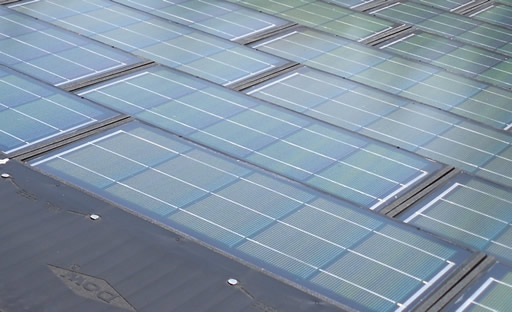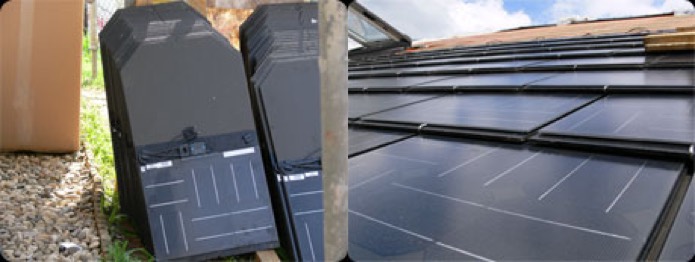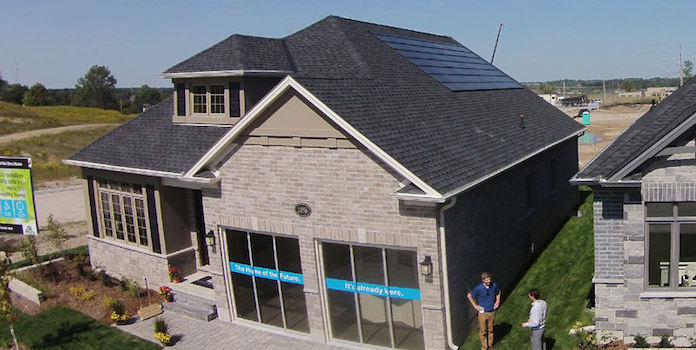How much does the Tesla Solar Roof cost?
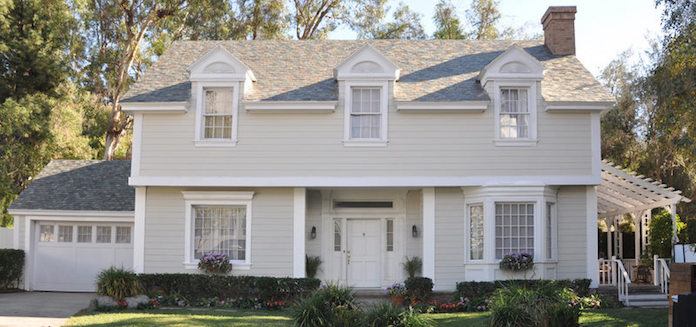
Tesla’s new solar roof tiles are poised to change the view on solar forever. The question now is: how much will a Tesla Solar Roof cost?
When you think of rooftop solar, you probably think of the classic solar panel setup you’ve seen for years (or maybe even have already). Tesla is looking to change that vision with their new solar roof tiles and, as with any new solar technology, we’re curious: how much will a Tesla Solar Roof cost?
While not technically shingles, these solar tiles from Tesla and Solarcity (who merged last year) are made to look like classic roofing materials to blend in seamlessly with the home. Sounds great – but does it come cheap? How much does the Tesla solar roof cost in comparison to a typical roof? Read on to find out more on Tesla-specific tiles, check out a solar shingles cost comparison, and understand the cost of solar shingles per square foot.
One thing: the solar roof tiles described in this article aren’t to be confused with Tesla’s recently-revealed low-profile solar panels, another interesting innovation! These are true panels – they cover existing shingles and roofing – but are designed to conceal the panel mounting hardware in order to make the installation blend into an existing roof better than a traditional solar setup.
The price claim
When Elon Musk announced the solar roof tiles in October 2016, he said that the solar tiles would be “comparable” in price to a typical roof, but didn’t offer specifics on price.
While no pricing specs have been released as of March 2017, Musk clarified his statement about the price being comparable to a typical roof. When he spoke to investors in November 2016, he said:
“the proposition would be, would you like a roof that looks better than the normal roof, lasts twice as long, costs less, and by the way, generates electricity?”
If you’re wondering how this could cost less than a normal roof, the Tesla website elaborates a little more, claiming that the solar tiles will have a “lower cost than a traditional roof when combined with projected utility bill savings.”
The last part of that sentence – factoring in the electricity bills you’d otherwise pay – is key to this claim. It helps us understand Musk’s claim a little better–the cost of the Tesla Solar Roof might cost more, but when you factor in the energy savings you will receive over time by having the roof, the two options work out to about the same. However, there are plenty of people out there who aren’t sure it can be done.
The skepticism
It isn’t hard to find skeptics of Musk’s cost claims or predictions of business success online. Most prominently, the CEO of SunPower, Tom Werner (a SolarCity competitor) shared his company’s failed attempt at solar tiles. They found that the inability of the shingles to keep themselves cool (not a big problem with panels installed on the roof because they have ventilation underneath) made them too expensive. Werner described it this way:
“a trade-off of looks cool versus costs more… our customers said it doesn’t look cool enough to offset.”
One prominent concern has been what Musk meant when he said the tiles will be comparable to a “normal roof.” When pressed to specify, he started discussing the price of ceramic tiles and concrete tile roofs, which aren’t cheap ($400-$2,000 per square roof, a square being 100 square feet).
However, the “normal roof” the majority of people have is an asphalt shingle roof, which typically runs $90 per 100 square feet. So it still isn’t clear what type of normal roof we are comparing here, but it could very well be pricier than you think.
Tesla solar roof cost – pricing estimates
Since we don’t know the actual prices yet, let’s examine some of the pricing estimates we’ve found online.
1. Motley Fool
A columnist at the Motley Fool who covers Tesla’s solar tiles ran a calculation to predict how the tiles might compare to traditional roofing. He estimated, based on current prices, a cost of $0.30 per watt to manufacture the tiles, which could come out to about $588 per 100 square feet (similar to those ceramic or concrete tiles discussed above).
But that’s not your only expense – you’ll still need to pay to have them installed. Using SolarCity’s ‘installed cost of $3/watt’, a reasonable comparison as it is owned by Tesla, the tiles come out to $5,880 per 100 square feet. If you look at a 3,000 square foot home, that could run you a $176,400 bill.
2. ConsumerReports
Consumer Reports worked to develop a target cost of installation that would factor in the expected electricity savings in order to be competitive with traditional roofing. They determined that this type of solar roof can’t exceed total upfront costs of $73,500 if it wants to be competitive with asphalt shingles (one of the cheapest standard options).
Using underlying data from roofing associations and assuming an average location, roof style, and size (3,000 square feet of roofing), the article concluded that asphalt shingling runs about $20,000 for a full rooftop installation.
They then factored in an assumption of a $2,000/year electric bill (that would theoretically be eliminated by the solar tiles), and Tesla’s stated life expectancy of 30 years for the tiles. Over time, that electricity savings should come out to around $60,000.
When the Powerwall is factored in (the battery energy storage device that will allow a home to utilize solar-generated electricity even when the sun isn’t out, which is required to eliminate an electric bill), that will cost another $6,500, so the ‘savings’ will be reduced to $53,500.
So assuming a $20,000 normal asphalt roof and $53,500 of savings over time, the Tesla option (for its ‘smooth or textured tile’) will need to cost you around $73,500 to be considered an equivalent.
3. GreenTech Media
An article from Greentech media expects that Tesla’s solar roof will average out as a 6kW system (which would cost about $15,000 if it were built with traditional panels) and save about $2,250 a year (assuming a high electricity rate of $0.25/kWh).
The reporter emphasizes the complexity of the installation, which is bound to be more complex than standard panels. With these factors taken into account, the payback time for the Tesla panels is estimated at 11 years.
The caveats
It’s important to note that these are estimates only, and they don’t account for variations and details. This includes the expectation from GreenTech Media that not all of the tiles will actually be functioning solar, due to slope faces and a setback from roof edges; the varying costs of electricity across the country; and the varying levels of sun available to produce solar power.
The articles also generally assume that the expense is an upfront cost (which is accurate, because a solar tile roof is different from solar panels in that it doubles as a home product, and thus isn’t likely to be available as a lease or PPA as with traditional panels), but don’t incorporate how that cost would work as a loan. The articles also don’t incorporate the 30% federal tax credit that we typically work into anticipated solar spending.
The calculations provided also assume that having a Tesla Solar Roof will totally eliminate an electricity bill, as opposed to just decreasing it. Finally, the cost estimates also can’t fully account for the complexity of installation as it compares to traditional solar. Any one of these factors can easily have a significant impact on the cost.
A cost comparison to other solar shingles on the market
The Tesla Solar Roof is not an entirely new concept. Other companies have tried the solar shingle / solar tile concept before. Some have failed, and some are still on the market. One of the prominent efforts to peter out was Dow Chemical’s Powerhouse Solar System, which lasted five years. It was the leading product for a time, but failed to sustain its business with consumers.
The Powerhouse system is frequently cited by business leaders as a reason that the solar shingle market hasn’t seen a boom, and also justification behind those in the industry who are skeptical of Musk’s claims to be able to drive the Tesla solar roof product line.
Other companies are still moving forward with solar shingle production and installation, but all are difficult to find costs on. It is important to remember that the companies below integrate their solar shingles and tiles with traditional roofing material, and the Tesla solar tiles will cover the entire roof–fully replacing it.
This provides an added value in the form of fully avoiding the costs of a normal roof, while Tesla’s competitors would still require you to cover much of your roof with normal shingles at your own cost in addition to the price of their systems.
Dow Chemical
While now out of business, it’s worth looking at this company because there is information out there about the expense. The Powerhouse system didn’t cover the entire roof. Instead, it came in large sets of ‘shingles’ that were set in alongside real roofing.
An installation of about 350 Powerhouse shingles could cost upwards of $20,000, and reduce household electricity consumption by 40-60%. Dow also outlines some cost measures in a press release, saying that “for an additional $27,480 over the cost of a traditional roof, you could receive $58,640 in energy savings over 25 years and potentially increase your home value by $33,000.”
CertainTeed
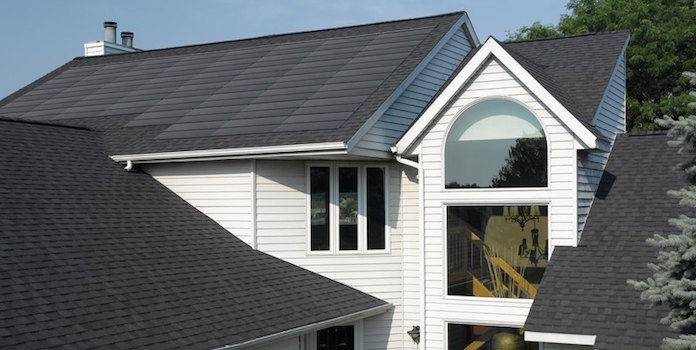
The largest existing company currently selling solar shingles is CertainTeed, which sells the Apollo II system through credentialed local solar installers. Again, this would be only part of your roof. CertainTeed honors the power output warranty–their website states that you can get 60 watts of energy per solar tile–for 25 years.
They also guarantee wind and impact protection. CertainTeed, similar to Dow, estimates that a 350 square foot layer of solar shingles costs around $20,000, and can cut your electric bill by 40-70%.
SunSlates
SunSlates are a product of Atlantis Energy Systems, and a standard set includes 216 slates and covers about 300 square feet of roof. The company uses trained installers to install the slates – essentially, a standard roofing slate (Eternit brand, a popular type of slate in Europe that allows for easy water runoff) with a panel glued onto the surface that is exposed to the sun.
The cost is fairly steep (a little higher than CertainTeed’s Apollo II product), estimated at $13,000 per 100 square feet in the FAQs, or $39,000 for the standard set. The company’s Eastern sales manager, however, quoted the cost at $8-10 per watt, somewhat smaller than that estimate. While this is cheaper than some of the estimates for Tesla, remember that it only covers part of the roof.
For more questions and answers, check out this FAQ sheet for SunSlate.
SunTegra
SunTegra produces both solar shingles that go with asphalt roofs and solar tiles that go with ceramic roofs. Both products have high rated efficiencies and also utilize a design that promotes ventilation which can keep the whole roof cooler (an issue for some companies in this space).
They are also reported to be lighter and easier to install than a typical rack mount system. While there isn’t much information available about cost, the SunTegra system is said to cost about 15% more than the same amount of solar when installed as a standard ‘rack’.
If you’re interested in solar roof tiles…
We will keep our eyes open for more information on Tesla solar roof pricing as it is released, so stay tuned! Predictions are currently expensive, but keep in mind that you would not only be paying for solar panels but also a new roof.
There is a good possibility that it does end up being a good deal when you add it all together. If you go with a solar tile roof, you won’t be paying your electricity bill (at least, not most of it), and you will have a stylish, valuable investment in your home.
Pricing is still yet to come, but orders will be open soon – Tesla reported that it will begin taking orders for solar roof tiles starting in April 2017. Think you’ll be signing up? Still want to hear more? Let us know in the comments section!
Photo Credits under CC License via Flickr & Courtesy of SolarCity, CertainTeed, SunSlates, SunTegra

